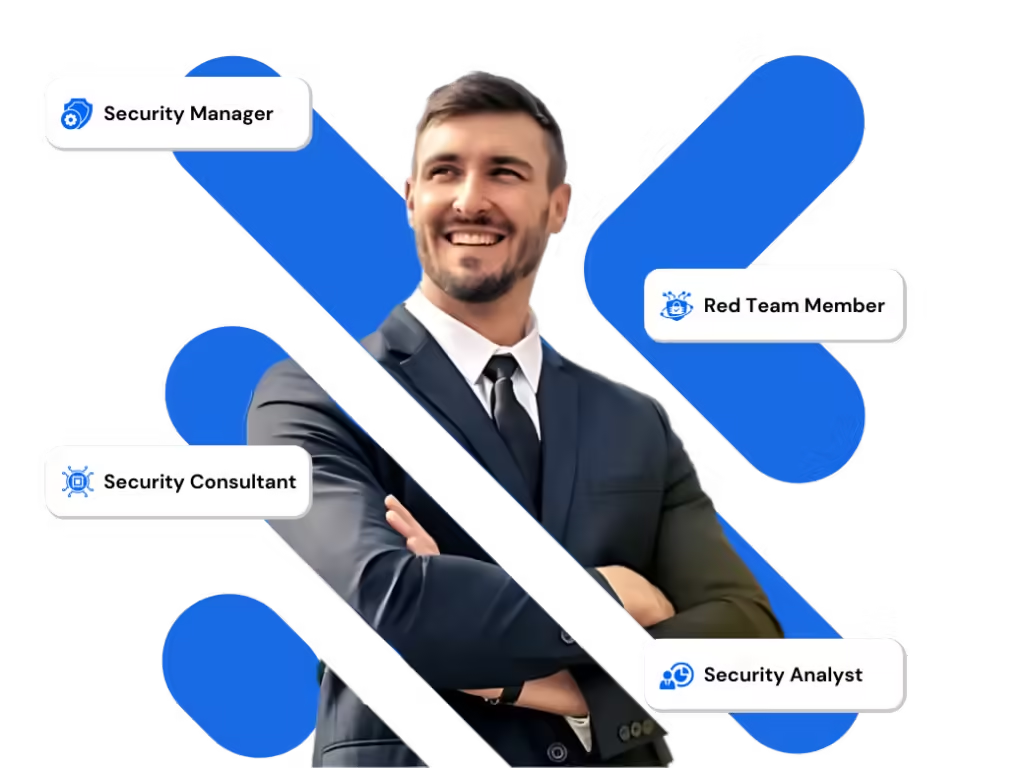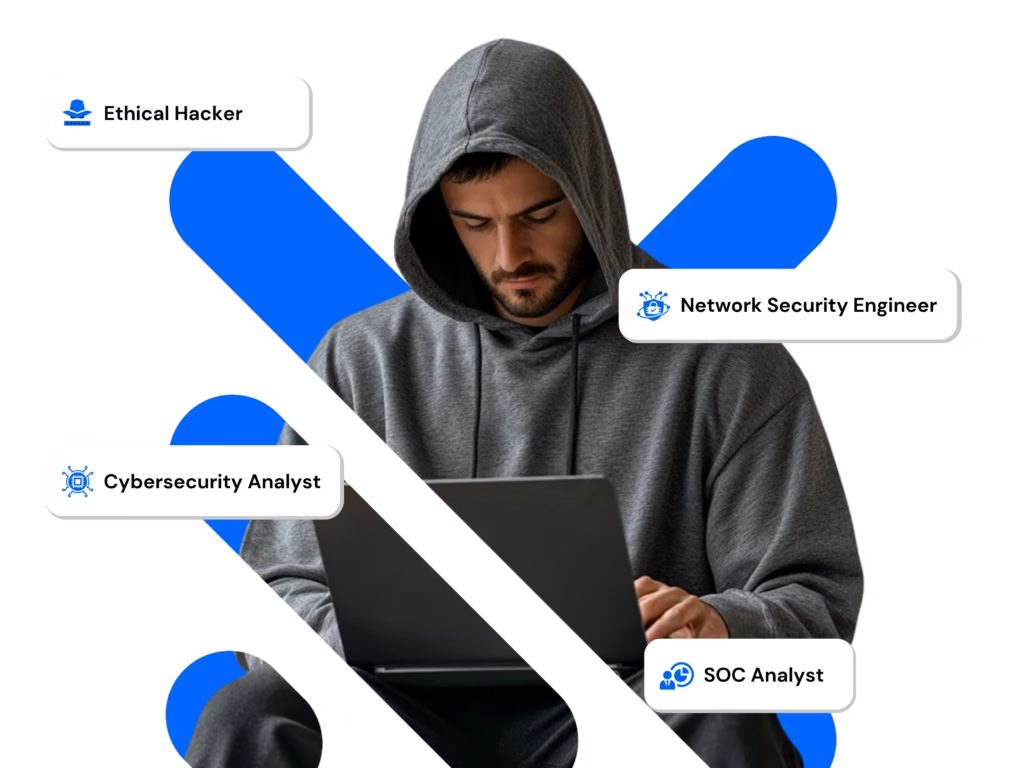Table of Contents
What is cybersecurity?
The increase in digital cyber-attacks has made cybersecurity a Main priority for businesses and individuals. For businesses, cyber-crimes can lead to data breaches, operational disruption, financial loss, and a loss of trust, while every person’s face individuality theft, financial scheme, and privacy attack. Cybersecurity is the rehearsal of guarding programs, networks and systems from digital attacks. These cyber-attacks are typically targeted at retrieving, changing, or terminating personal data; extracting money from users through ransomware; or disturbing normal business procedures. Applying operative cybersecurity methods is mainly stimulating today because there are more devices than people, and attackers are becoming more inventive.
A fruitful cybersecurity position has numerous layers of guard spread through the programs, networks, computers or data that one means to keep safe. In an association, a united threat organization gateway system can automate integrations through products and accelerate key safety processes functions: remediation, investigation and detection. People, procedures, and skill must all complement one additional to make an operative defense from cyber-attacks.
For those looking to establish a strong career in cybersecurity, Senseacademy offers the best cybersecurity course in Dehradun, providing a comprehensive curriculum, hands-on training, and expert mentorship. Our program ensures that students gain real-world experience in threat detection, investigation, and remediation.
Why is cybersecurity important?
In today’s associated world, everyone profits from Innovative cybersecurity solutions. At a single level, a cybersecurity attack can outcome in all from individuality theft to extortion efforts, to the loss of important information like family photos. Everyone trusts on dangerous organization like financial service companies, hospitals and power plants. Safeguarding these and other administrations is necessary to keeping our society functioning.
Everyone also profits from the work of cyber-threat investigators, like the team of 250 risk investigators at Talos, who examine new and evolving risks and cyber-attack policies. They disclose new susceptibilities, teach the public on the importance of cybersecurity, and support open-source tools. Their work makes the internet safer for everybody.
Common threat types
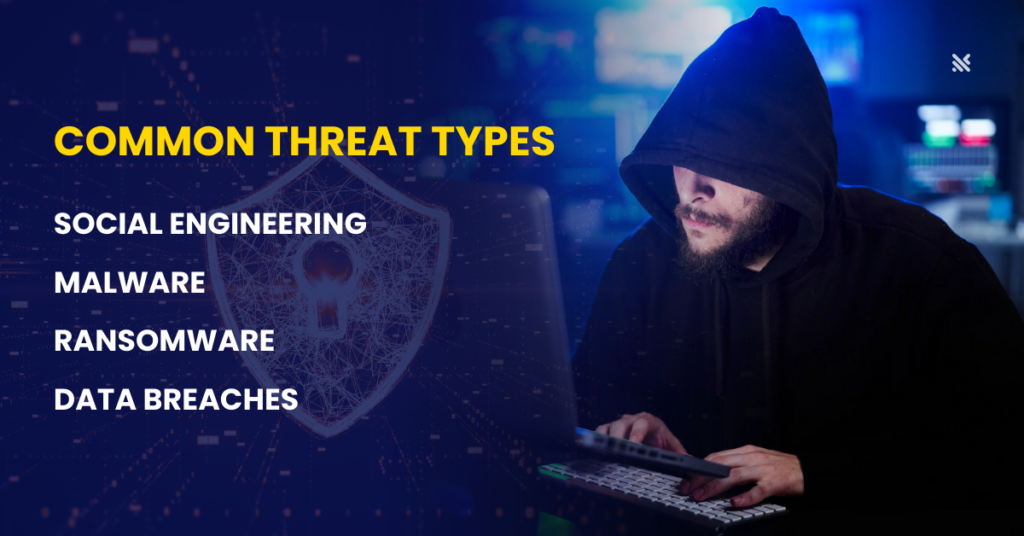
These are the most common cyber threats your administration may face:
Social engineering: Social engineering includes operating people to disclose private info. The attacker may pose as a trusted person or authority figure to improve contact or info.
Malware: Malware (malicious software) can harm systems or snip information. This contains:
- Bugs that spread among systems
- Spyware that observers user action
- Trojans that seem genuine but contain damaging code
Phishing: Phishing efforts to snip private information by masquerading as dependable objects. These attacks often reach via email and can aim exact individuals or societies.
Ransomware: Ransomware encrypts your information and demands payment for its release. This can stop processes and cause important financial damage.
Data breaches: Data breaches happen when illegal parties increase contact to trustworthy info, often through a mixture of the above approaches.
Popular Cybersecurity Courses
For individuals and professionals looking to strengthen their cybersecurity knowledge and skills, various cybersecurity courses are available. These courses cover essential security principles, tools, and best practices for defending against cyber threats.
Popular Cybersecurity Courses:
- Certified Ethical Hacker (CEH v13 With AI Training) – Focuses on penetration testing and ethical hacking techniques.
- Certified Threat Intelligence Analyst (CTIA) – Provides expertise in gathering and analyzing threat intelligence.
- CompTIA A+ – Covers foundational IT knowledge, including hardware, networking, and security basics.
- CompTIA Security+ – Provides foundational knowledge of cybersecurity concepts, risk management, and network security.
- Certified Network Defender (CND) – Focuses on network security and defense strategies.
- Certified Incident Handler (ECIH) – Trains professionals in managing and responding to security incidents.
- CompTIA Network+ – Covers networking concepts, security, and troubleshooting.
- CompTIA Linux+ – Focuses on Linux system administration and security.
- Cybersecurity Analyst (CySA+) – Provides training in threat detection and security analytics.
- Advanced Security Practitioner (CASP+) – Covers advanced security solutions and risk management.
These courses help individuals build expertise in cybersecurity and prepare for careers in the industry. for more information visit Senseacademy
Types of Cybersecurity Solutions
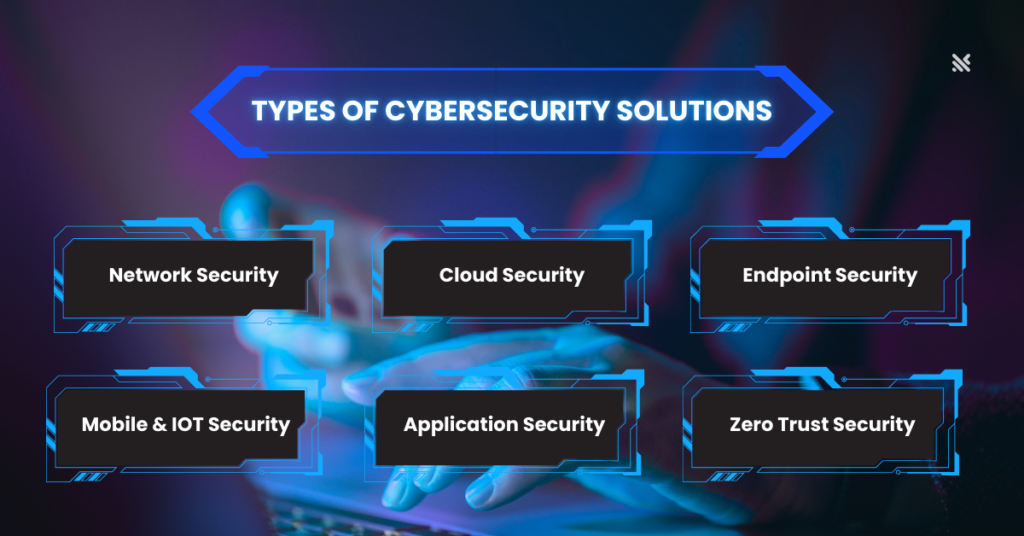
As cyber threats continue to evolve, organizations must implement comprehensive security measures to protect their networks, data, and systems. Below are key cybersecurity solutions that safeguard against various threats.
Network Security
Most cyberattacks occur over the network, making network security a critical defense mechanism. These solutions detect and block malicious activities using advanced controls, including:
- Access and Data Protection: Data Loss Prevention (DLP), Identity Access Management (IAM), Network Access Control (NAC), and Next-Generation Firewalls (NGFW).
- Advanced Threat Prevention: Intrusion Prevention Systems (IPS), Next-Gen Antivirus (NGAV), Sandboxing, and Content Disarm and Reconstruction (CDR).
- Threat Intelligence & Response: Network analytics, threat hunting and automated Security Orchestration, Automation, and Response (SOAR) solutions.
Cloud Security
With organizations shifting to cloud computing, securing cloud environments is a top priority. Cloud security involves:
- Data Protection: Encryption, access controls, and compliance monitoring.
- Threat Prevention: Cloud-based firewalls, malware scanning, and vulnerability management.
- Third-Party Security Solutions: Many cloud providers offer basic security, but businesses often require additional protection to defend against data breaches and targeted attacks.
Endpoint Security
Endpoints like laptops, desktops, and other user devices are prime targets for cyberattacks. Endpoint security provides:
- Zero Trust Architecture: Micro-segmentation to secure data at every access point.
- Advanced Threat Protection: Anti-phishing, anti-ransomware, and Endpoint Detection and Response (EDR) solutions.
- Device Monitoring: Forensics and behavioral analysis to detect suspicious activity.
Mobile Security
Smartphones and tablets hold sensitive corporate data but are often overlooked in security strategies. Mobile security ensures:
- Protection from Malicious Apps: Defense against zero-day exploits, phishing attacks, and instant messaging (IM) threats.
- Secure Device Management: Prevents rooting and jail breaking, ensuring device integrity.
- Mobile Device Management (MDM): Enforces security policies, ensuring only compliant devices can access corporate networks.
IoT Security
The Internet of Things (IoT) brings convenience but also introduces new vulnerabilities. Cybercriminals target insecure IoT devices to gain unauthorized access. IoT security includes:
- Device Discovery & Classification: Identifies all connected IoT devices.
- Auto-Segmentation: Restricts unauthorized network activities.
- Virtual Patching: Uses IPS to protect devices from exploits.
- Firmware Security: Prevents runtime attacks with embedded security agents.
Application Security
Web applications are frequent targets for cybercriminals, exploiting vulnerabilities such as SQL injection, authentication flaws, and misconfigurations. Application security measures include:
- OWASP Top 10 Protection: Defends against the most common application security risks.
- Bot Protection: Detects and blocks automated attacks on applications and APIs.
- Continuous Learning: AI-driven solutions adapt to new threats as DevOps teams release updates.
Zero Trust Security
Traditional security models focus on perimeter defense, which is no longer effective with cloud adoption and remote work. The Zero Trust model ensures that:
- Micro-Segmentation: Limits access to sensitive resources.
- Strict Identity Verification: Requires authentication before granting access.
- Least Privilege Access: Ensures users and devices only access what they need.
Additional Emerging Cybersecurity Solutions
- AI & Machine Learning Security: Uses AI-driven analytics to predict and prevent cyber threats.
- Security Awareness Training: Educates employees to recognize phishing, social engineering, and cyber threats.
- Blockchain Security: Provides decentralized security solutions for data integrity and authentication.
By adopting a multi-layered cybersecurity approach, organizations can better protect themselves against the ever-evolving landscape of cyber threats.
Best practices for cybersecurity
Accepting best practices for cybersecurity can knowingly decrease the threat of cyber-attacks.
Here are three key practices:
- Regular software and operating system updates
Modernizing software and functioning systems frequently assist to cover weaknesses and improve safety methods beside possible risks.
- Using strong and unique passwords
Generating strong and exclusive passwords for each online account can improve cybersecurity, as cyber-attacks often utilize feeble or stolen passwords.
- Implementing multi-factor authentication (MFA)
Multi-factor verification includes numerous documentation forms before account contact, decreasing the threat of unapproved contact. Cisco Duo contains MFA that can assimilate with utmost main requests as well as custom apps.
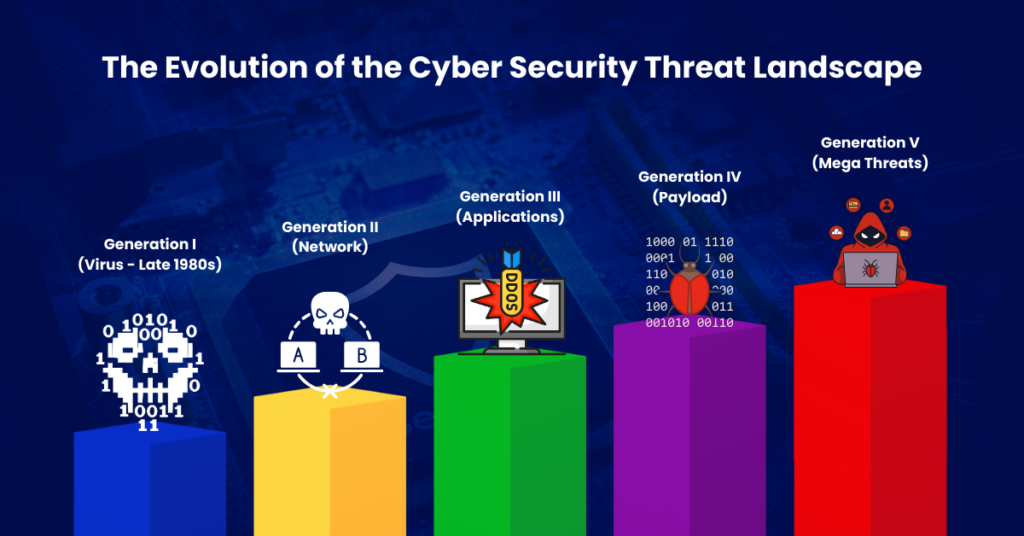
The Evolution of the Cyber Security Threat Landscape
The cyber risks of today are not the similar as even a few years ago. As the cyber threat scenery variations, administrations need security beside cybercriminals’ present and upcoming tools and methods.
Gen V Attacks
The cyber security threat landscape is repeatedly developing, and, infrequently, these developments signify a new generation of cyber threats. To date, we have knowledgeable five peers of cyber threats and solutions intended to alleviate them, counting:
Generation I (Virus – Late 1980s)
The rise of standalone computer viruses led to the development of the first antivirus programs.
Generation II (Network)
As cyber threats spread via the Internet, firewalls were introduced to detect and block unauthorized access.
Generation III (Applications)
Exploiting application vulnerabilities became common, driving the adoption of intrusion prevention systems (IPS).
Generation IV (Payload)
Advanced malware capable of bypassing traditional security required anti-bot and sandboxing solutions for detection.
Generation V (Mega Threats)
Modern cyberattacks utilize large-scale, multi-vector approaches, making advanced threat prevention essential.
Every generation of cyber threats made earlier cyber security solutions less operative or basically outdated. Defensive beside the modern cyber threat scenery needs Gen V cyber safety solutions.
Explore: What is CEH Certification? Benefits, Job & Exam Tips (2024)
FAQ
What is the difference between Cybersecurity and Information Security?
Cybersecurity focuses on protecting digital assets, networks, and systems from cyber threats, while Information Security covers the broader concept of securing all forms of data, whether digital or physical.
How does Artificial Intelligence (AI) impact Cybersecurity?
AI enhances cybersecurity by automating threat detection, analyzing patterns, and predicting potential attacks. However, cybercriminals also use AI for advanced hacking techniques.
What is Zero Trust Security?
Zero Trust is a security model that requires strict identity verification for every person and device trying to access a network, minimizing unauthorized access risks.
How do Cybersecurity Regulations impact businesses?
Regulations like GDPR, HIPAA, and CCPA mandate data protection measures, requiring businesses to implement strong security controls to avoid legal penalties and data breaches.

